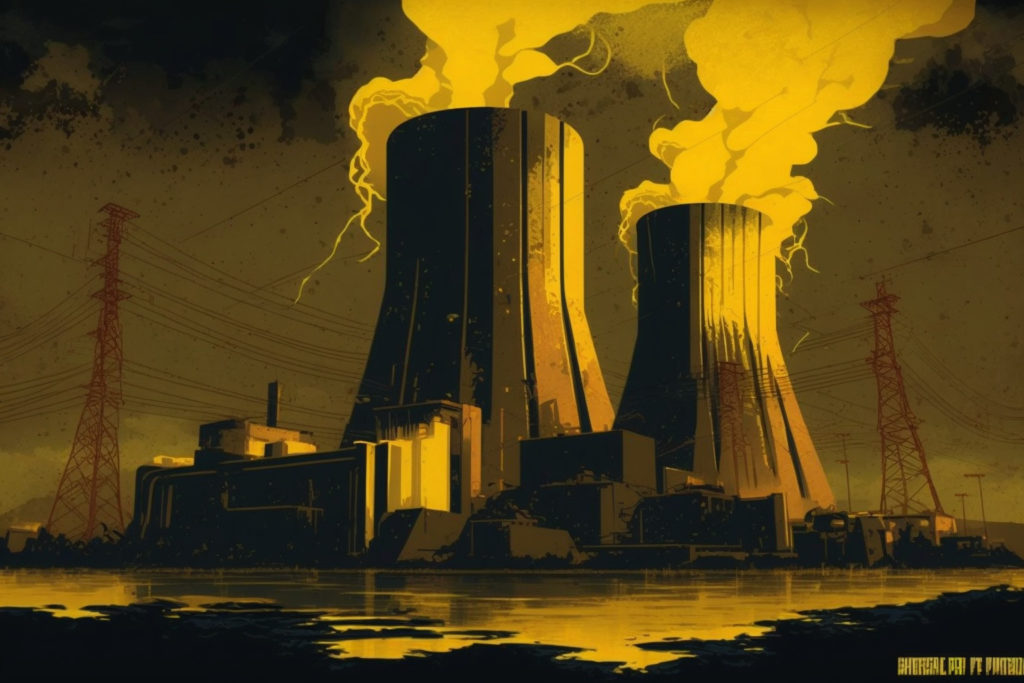I. Introduction
Nuclear energy is a crucial aspect of modern society, providing a significant portion of the world’s electricity needs. The importance of understanding the impact, benefits, and drawbacks of nuclear energy cannot be overstated, as the world continues to grapple with issues related to energy production and consumption. The purpose of this article is to present a comprehensive overview of the pros and cons of nuclear energy, with a specific focus on safety and efficiency.
The growth of the nuclear energy industry has been steady over the past few decades, and it remains a significant player in the global energy market. With a total of 448 nuclear reactors operating in 30 countries around the world, it’s vital to understand the latest developments in the industry, including safety measures and efficiency improvements.
This report aims to provide a detailed analysis of the latest trends in the nuclear energy sector, drawing on the latest research and data to provide an informed overview of the industry’s current state and future projections. Whether you’re a market researcher, investor, or simply interested in the future of energy production, this article has something for everyone.
Before we delve into the pros and cons of nuclear energy, it’s important to understand the definition of nuclear energy and the basic principles behind its generation. Nuclear energy is the energy released by nuclear reactions, either through nuclear fission or fusion. In nuclear fission, heavy atomic nuclei are split into lighter ones, releasing energy in the process. This energy is harnessed in nuclear power plants to generate electricity.
Now that we have a basic understanding of what nuclear energy is and how it’s generated, let’s take a closer look at the pros and cons of this form of energy production.
Global Nuclear Electricity Market Financial Analysis
The global nuclear electricity market is segmented by reactor type (Pressurized Water Reactors (PWR), Fast Breeder Reactor (FBR), Pressurized Heavy-Water Reactor (PHWR), Boiling Water Reactor (BWR), Light Water Graphite Reactor (LWGR), Gas-Cooled Reactor (GCR)), end-user (Residential, Commercial, Industrial), and technology (Generation I, Generation II, Generation III, and Generation IV).
According to a recent market research report, the global nuclear electricity market size is expected to grow from $204.41 billion in 2022 to $217.4 billion in 2023 at a compound annual growth rate (CAGR) of 6.4%. (Business Research Company, 2023)

Electricity Demand as the Key Driver for Nuclear Energy
The growth of the market is driven by the increasing demand for electricity, which is expected to be a key driver of the nuclear power generation market in the forecast period. This can be attributed to growing economies and rising populations, especially in developing countries such as China, India, Brazil, and some African countries. According to the International Energy Agency (IEA), global electricity demand is projected to rise at 2.1% per year by 2040, twice the rate of primary energy demand.
Furthermore, the growth of the global household appliances market, expected to reach $396 billion by 2022, is also expected to drive the demand for electricity and support the growth of the nuclear electricity market.
However, the industry also faces challenges, including the increasing vulnerability to cyber-attacks. For instance, in October 2022, Tata Power, an Indian-based electric power distribution company, suffered a cyber-attack. This highlights the importance of implementing robust cybersecurity measures to ensure the safety and efficiency of nuclear energy systems. (Economic Times, 2022)
Overall, despite the challenges, the global nuclear electricity market is expected to grow in the short and long-term, driven by the growing demand for electricity and increasing adoption of nuclear energy as a source of power. The market size is expected to reach $271.08 billion by 2027, with a CAGR of 5.7%.
II. The Pros of Nuclear Energy
Nuclear energy is a critical component of the world’s energy mix, providing a significant portion of electricity to many countries. The benefits of nuclear energy are many and varied, ranging from increased safety to improved efficiency. In this section, we will explore some of the most important advantages of nuclear energy and highlight real-world examples of successful nuclear energy projects.
Safety improvements in the nuclear power industry
One of the key benefits of nuclear energy is the significant progress that has been made in terms of safety. Modern nuclear power plants are equipped with a range of advanced safety features, including multiple redundant systems and enhanced accident management procedures. For example, the Westinghouse AP1000 reactor, which is used in several countries around the world, has a passive cooling system that provides an extra layer of safety in the event of a power outage or other emergency. This system, combined with other advanced safety features, makes the AP1000 one of the safest nuclear reactors in the world.
To further improve safety in the nuclear energy industry, many countries have established independent regulatory agencies to oversee the development and operation of nuclear power plants. These agencies play a crucial role in ensuring that nuclear power plants are operated in a safe and responsible manner, and they have the authority to impose fines and other penalties on operators who violate safety regulations. The International Atomic Energy Agency (IAEA) is a global organization that provides guidance on nuclear safety and promotes the safe use of nuclear energy around the world.
Increased efficiency in nuclear power plants
Another major advantage of nuclear energy is the improved efficiency of modern nuclear power plants. Advances in technology and engineering have led to significant increases in the output of nuclear reactors, enabling them to generate more electricity with less fuel. This improved efficiency has helped to reduce the cost of nuclear energy and increase its competitiveness with other forms of electricity generation.
One example of a highly efficient nuclear power plant is the Olkiluoto 3 reactor in Finland. This reactor is equipped with the latest technology, including advanced control systems and a more efficient fuel design. As a result, the Olkiluoto 3 reactor is able to generate more electricity with less fuel than older nuclear reactors, and it has a higher capacity factor (the ratio of actual output to potential output) than many other nuclear reactors around the world.
Real-world examples of successful nuclear energy projects
There are numerous real-world examples of successful nuclear energy projects that demonstrate the benefits of this form of energy generation. One of the most notable is the French nuclear energy program, which has been operating for several decades and provides a significant portion of the country’s electricity. France’s nuclear energy program has a strong safety record and a high level of efficiency, and it has helped the country to achieve energy independence and reduce its greenhouse gas emissions.
Another example of a successful nuclear energy project is the Taishan Nuclear Power Plant in China, which is one of the most advanced and efficient nuclear reactors in the world. The Taishan plant is equipped with the latest technology, including a state-of-the-art control system and advanced cooling systems, and it has a high capacity factor. This plant is a testament to the potential of nuclear energy to provide safe, reliable, and efficient electricity to communities around the world.
III. The Cons of Nuclear Energy
While nuclear energy has a number of benefits, it also comes with some drawbacks. The most significant of these are concerns surrounding nuclear energy safety and inefficiencies in current technology.
Concerns Surrounding Nuclear Energy Safety
One of the most persistent criticisms of nuclear energy is the potential for catastrophic accidents. The nuclear disaster at Fukushima Daiichi in 2011 is a prime example of the dangers of nuclear power. Despite improvements in safety regulations and technology, the risk of a nuclear accident remains a concern for many people. In addition, the safe disposal of nuclear waste is still a challenge, and there are concerns about the potential for radioactive materials to leak into the environment.
Inefficiencies in Current Nuclear Power Technology
Another major criticism of nuclear energy is its inefficiencies. Nuclear power plants are expensive to build and maintain, and the costs associated with decommissioning a plant can be substantial. In addition, the limited availability of fuel for nuclear reactors is a concern, as the world’s uranium reserves are finite. This has led to increased competition for resources and higher costs for nuclear energy production.
Real-World Examples of Nuclear Energy Failures
In recent years, there have been a number of high-profile failures in the nuclear energy industry. For example, the Vogtle nuclear power plant in Georgia was plagued by cost overruns and construction delays, leading to a $2 billion cost increase for ratepayers. Similarly, the Summer nuclear power plant in South Carolina was abandoned in 2017 after billions of dollars had been spent on its construction. These failures highlight the challenges and risks associated with the nuclear energy sector, and raise questions about the long-term viability of the industry.
Despite these concerns, the nuclear energy industry remains an important source of electricity for many countries. As technology continues to advance, it is likely that the efficiency and safety of nuclear energy production will improve. However, it is important to remain vigilant in monitoring and addressing the potential risks associated with nuclear power.

The Future of Nuclear Energy
The nuclear energy industry is constantly evolving, with advancements being made in safety and efficiency on a regular basis. The future of nuclear energy looks promising, with many experts predicting continued growth in the industry. Let’s take a closer look at what’s in store for the future of nuclear energy.
Overview of the Current State of the Nuclear Energy Industry
Currently, there are approximately 450 nuclear reactors in operation worldwide, producing approximately 11% of the world’s electricity. The majority of these reactors are located in developed countries such as the United States, France, and Japan. While the number of reactors has remained relatively stable in recent years, the industry is facing increasing competition from renewable energy sources such as solar and wind power. Despite this competition, the nuclear energy industry continues to be an important player in the global energy mix.
Future Advancements in Nuclear Energy Safety and Efficiency
The continued advancement of technology is driving improvements in the safety and efficiency of nuclear energy. New reactor designs, such as small modular reactors (SMRs), promise to be safer and more efficient than traditional nuclear reactors. SMRs are much smaller in size than traditional reactors, making them easier to transport and install. This is especially important for countries that are looking to build new reactors but lack the infrastructure to support large-scale nuclear power plants. Additionally, SMRs are designed to be passively safe, meaning that in the event of an emergency, the reactors will automatically shut down without the need for human intervention.
Another important advancement in the nuclear energy industry is the development of advanced fuel cycles. These advanced fuel cycles have the potential to significantly increase the efficiency of nuclear reactors, while also reducing the amount of nuclear waste produced. This is an important development, as the disposal of nuclear waste remains one of the biggest challenges facing the nuclear energy industry.
Projections for the Future of the Nuclear Energy Industry
While the future of the nuclear energy industry is uncertain, many experts predict that the industry will continue to grow. According to a recent report by the International Energy Agency (IEA), the global nuclear energy capacity is expected to increase by 50% by 2050. This growth is driven by the increasing demand for electricity, as well as the continued advancements in nuclear energy technology.
In addition to the IEA’s predictions, many countries are making significant investments in nuclear energy. For example, China is currently building more than 20 new reactors, with plans to increase this number in the future. Similarly, India is also investing heavily in nuclear energy, with plans to build up to 10 new reactors in the coming years.
Despite the potential for growth, the nuclear energy industry faces significant challenges. The high cost of building and operating nuclear reactors, as well as the public’s concerns about safety, remain significant obstacles to the continued growth of the industry. However, if the industry can overcome these challenges, the future of nuclear energy looks bright.
While the future of the nuclear energy industry is uncertain, the continued advancements in technology and the growing demand for electricity suggest that the industry will continue to grow. It is important for finance professionals and investors to stay informed about the latest developments in the industry, in order to make informed decisions about investment opportunities in the sector.
V. Conclusion
In conclusion, the nuclear energy industry is one of great potential, but also with its own set of challenges. The pros of nuclear energy include improved safety measures, increased efficiency, and successful real-world examples. However, the cons of nuclear energy cannot be ignored, including ongoing concerns surrounding safety and inefficiencies in current technology. Despite these challenges, the future of nuclear energy is bright, with continued advancements in safety and efficiency and projections for significant growth in the industry.
It is crucial to understand the current state and future of the nuclear energy industry in order to make informed investment and research decisions. The industry is constantly evolving, and staying informed on the latest developments and projections is essential. The data supports the continued growth and potential of nuclear energy, and the industry offers exciting opportunities for those willing to invest in it.
So, if you’re looking to invest in the energy sector or want to stay updated on the latest industry trends, now is the perfect time to dive into the world of nuclear energy. Read up on the latest reports and studies, attend industry conferences and events, and connect with experts in the field. The future of energy is here, and nuclear energy is at the forefront of it all.
In the end, it is up to each individual to weigh the pros and cons of nuclear energy and make informed decisions about their involvement in the industry. By staying informed and up-to-date on the latest developments, you can make a difference in shaping the future of energy.
Sources:
- International Energy Agency, Global World Energy Outlook 2022,
- World Nuclear Association, Economic Aspects of Nuclear Power,
- U.S. Energy Information Administration, Electricity Data 2023
See our other reports
We hope you found this report on Nuclear Energy, Nuclear Power, Nuclear Energy Safety, and Nuclear Energy Efficiency informative and comprehensive. As industry experts, we believe that understanding the current trends and projections in various industries is crucial for finance professionals and investors. That’s why we encourage you to read our other reports that delve into various industries and their growth prospects.
For instance, our report on Sustainable Manufacturing: The Link Between Environmental Factors and Prosperity provides insight into the impact of sustainable practices on the manufacturing sector’s growth. Similarly, our report on Powering Up: A Look into the Future of the Utilities and Power Sector analyzes the future prospects of the utilities and power sector.
Moreover, our report on The Future of Industry: How Artificial Intelligence is Driving Growth delves into the impact of artificial intelligence on various industries. Additionally, our report on Transportation and Beyond: How Infrastructure Impacts the Growth of the Logistics Industry provides an in-depth analysis of the impact of infrastructure on the logistics industry.
We also have reports on the future of banking and online services trends in our The Future of Banking: Online Services Trends report, a comprehensive analysis of global e-commerce growth forecast in 2023 in our Global E-Commerce Growth Forecast 2023: A Comprehensive Analysis report, and the potential of geothermal energy as power and heating solutions in our The Potential of Geothermal Energy: Power and Heating Solutions report.
We believe that these reports will provide valuable insights and help finance professionals and investors make informed decisions.











